The Enron Scandal: An Analysis of Accounting Fraud and Ethical Lapses
VerifiedAdded on 2022/11/10
|14
|4336
|339
Essay
AI Summary
This essay provides a detailed analysis of the Enron case, focusing on the misuse of accounting practices that led to its downfall. The essay begins by explaining the mark-to-market accounting approach and how Enron manipulated it to inflate its financial performance, including examples of long-term contracts and misrepresented costs. It then explores the role of special purpose entities (SPEs) and how Enron used them to hide debt and manipulate its financial statements, violating accounting principles. The essay also discusses the stock options compensation scheme provided to Enron's top management and its implications in the context of agency theory. Finally, it examines the ethical lapses and failures in the company's code of conduct, providing recommendations to prevent similar fraudulent activities in the future. The analysis highlights the importance of ethical accounting practices and the dangers of financial manipulation.

Running head: ACCOUNTING THEORY
Accounting Theory
Name of the Student
Name of the University
Author’s note
Accounting Theory
Name of the Student
Name of the University
Author’s note
Paraphrase This Document
Need a fresh take? Get an instant paraphrase of this document with our AI Paraphraser

1ACCOUNTING THEORY
Introduction
The essay tends to provide a detailed description regarding fall of the Enron case. In
the context of this discussion, certain points are important. The essay structures in the
following manner. In the beginning section, the mark-to-market accounting approach is
elaborated. The usage of this approach in accounting procedures is also briefed. In this
context different examples and situations are cited from the Enron case that shows the misuse
of this approach in order to portray a false picture. It is derived from this picture that the
management of Enron has misused this approach in order to increase their profitability figure
and enhance their performances.
The essay further talks about the special purpose entities which are used in accounting
and the usage of these entities in the Enron company for the purpose of funding contracts and
also to achieve the objectives of financial reporting. The essay moves on to discuss about the
stock options compensation scheme that is enjoyed by the top management of Enron. The
point is dictated through the agency theory. At the last section a complete picture is provided
regarding principles followed in the code of the conduct of professional accounting. In this
respect it is pointed out whether Enron company has abided by the code of conduct of
professional accounting. Suitable reasons are provided stating the justification of the
statements. Suitable points are noted down in order to provide a thorough and detailed
explanation of the fraud case of Enron company and necessary recommendations are also
given in order to curb such a critical issue.
Mark-to-market accounting approach and the misuse of this approach by Enron
company
Mark-to-market accounting approach can be defined as an accounting practice that
relates to the value of an asset for defining the current level of the market. It is recommended
Introduction
The essay tends to provide a detailed description regarding fall of the Enron case. In
the context of this discussion, certain points are important. The essay structures in the
following manner. In the beginning section, the mark-to-market accounting approach is
elaborated. The usage of this approach in accounting procedures is also briefed. In this
context different examples and situations are cited from the Enron case that shows the misuse
of this approach in order to portray a false picture. It is derived from this picture that the
management of Enron has misused this approach in order to increase their profitability figure
and enhance their performances.
The essay further talks about the special purpose entities which are used in accounting
and the usage of these entities in the Enron company for the purpose of funding contracts and
also to achieve the objectives of financial reporting. The essay moves on to discuss about the
stock options compensation scheme that is enjoyed by the top management of Enron. The
point is dictated through the agency theory. At the last section a complete picture is provided
regarding principles followed in the code of the conduct of professional accounting. In this
respect it is pointed out whether Enron company has abided by the code of conduct of
professional accounting. Suitable reasons are provided stating the justification of the
statements. Suitable points are noted down in order to provide a thorough and detailed
explanation of the fraud case of Enron company and necessary recommendations are also
given in order to curb such a critical issue.
Mark-to-market accounting approach and the misuse of this approach by Enron
company
Mark-to-market accounting approach can be defined as an accounting practice that
relates to the value of an asset for defining the current level of the market. It is recommended
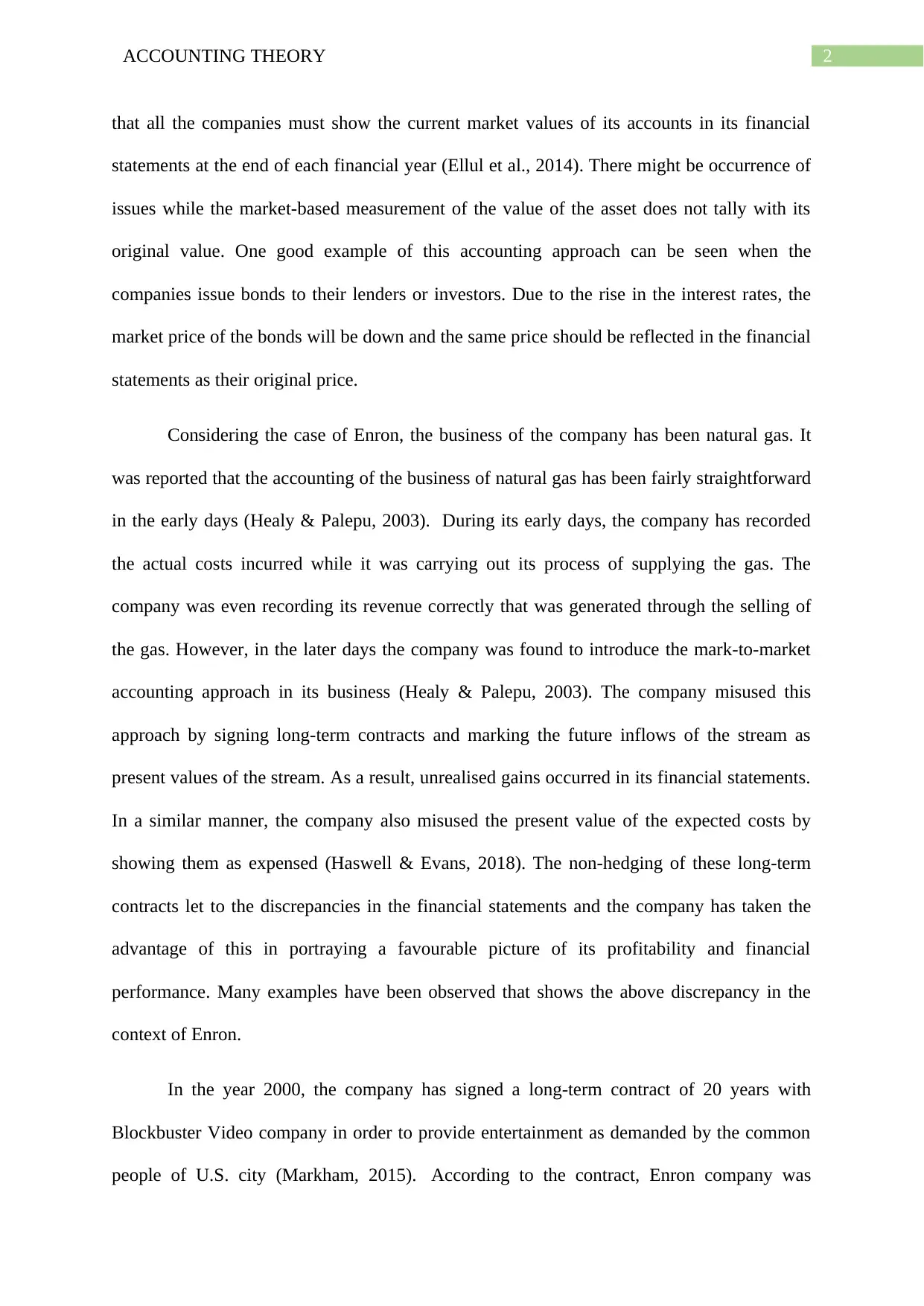
2ACCOUNTING THEORY
that all the companies must show the current market values of its accounts in its financial
statements at the end of each financial year (Ellul et al., 2014). There might be occurrence of
issues while the market-based measurement of the value of the asset does not tally with its
original value. One good example of this accounting approach can be seen when the
companies issue bonds to their lenders or investors. Due to the rise in the interest rates, the
market price of the bonds will be down and the same price should be reflected in the financial
statements as their original price.
Considering the case of Enron, the business of the company has been natural gas. It
was reported that the accounting of the business of natural gas has been fairly straightforward
in the early days (Healy & Palepu, 2003). During its early days, the company has recorded
the actual costs incurred while it was carrying out its process of supplying the gas. The
company was even recording its revenue correctly that was generated through the selling of
the gas. However, in the later days the company was found to introduce the mark-to-market
accounting approach in its business (Healy & Palepu, 2003). The company misused this
approach by signing long-term contracts and marking the future inflows of the stream as
present values of the stream. As a result, unrealised gains occurred in its financial statements.
In a similar manner, the company also misused the present value of the expected costs by
showing them as expensed (Haswell & Evans, 2018). The non-hedging of these long-term
contracts let to the discrepancies in the financial statements and the company has taken the
advantage of this in portraying a favourable picture of its profitability and financial
performance. Many examples have been observed that shows the above discrepancy in the
context of Enron.
In the year 2000, the company has signed a long-term contract of 20 years with
Blockbuster Video company in order to provide entertainment as demanded by the common
people of U.S. city (Markham, 2015). According to the contract, Enron company was
that all the companies must show the current market values of its accounts in its financial
statements at the end of each financial year (Ellul et al., 2014). There might be occurrence of
issues while the market-based measurement of the value of the asset does not tally with its
original value. One good example of this accounting approach can be seen when the
companies issue bonds to their lenders or investors. Due to the rise in the interest rates, the
market price of the bonds will be down and the same price should be reflected in the financial
statements as their original price.
Considering the case of Enron, the business of the company has been natural gas. It
was reported that the accounting of the business of natural gas has been fairly straightforward
in the early days (Healy & Palepu, 2003). During its early days, the company has recorded
the actual costs incurred while it was carrying out its process of supplying the gas. The
company was even recording its revenue correctly that was generated through the selling of
the gas. However, in the later days the company was found to introduce the mark-to-market
accounting approach in its business (Healy & Palepu, 2003). The company misused this
approach by signing long-term contracts and marking the future inflows of the stream as
present values of the stream. As a result, unrealised gains occurred in its financial statements.
In a similar manner, the company also misused the present value of the expected costs by
showing them as expensed (Haswell & Evans, 2018). The non-hedging of these long-term
contracts let to the discrepancies in the financial statements and the company has taken the
advantage of this in portraying a favourable picture of its profitability and financial
performance. Many examples have been observed that shows the above discrepancy in the
context of Enron.
In the year 2000, the company has signed a long-term contract of 20 years with
Blockbuster Video company in order to provide entertainment as demanded by the common
people of U.S. city (Markham, 2015). According to the contract, Enron company was
⊘ This is a preview!⊘
Do you want full access?
Subscribe today to unlock all pages.

Trusted by 1+ million students worldwide
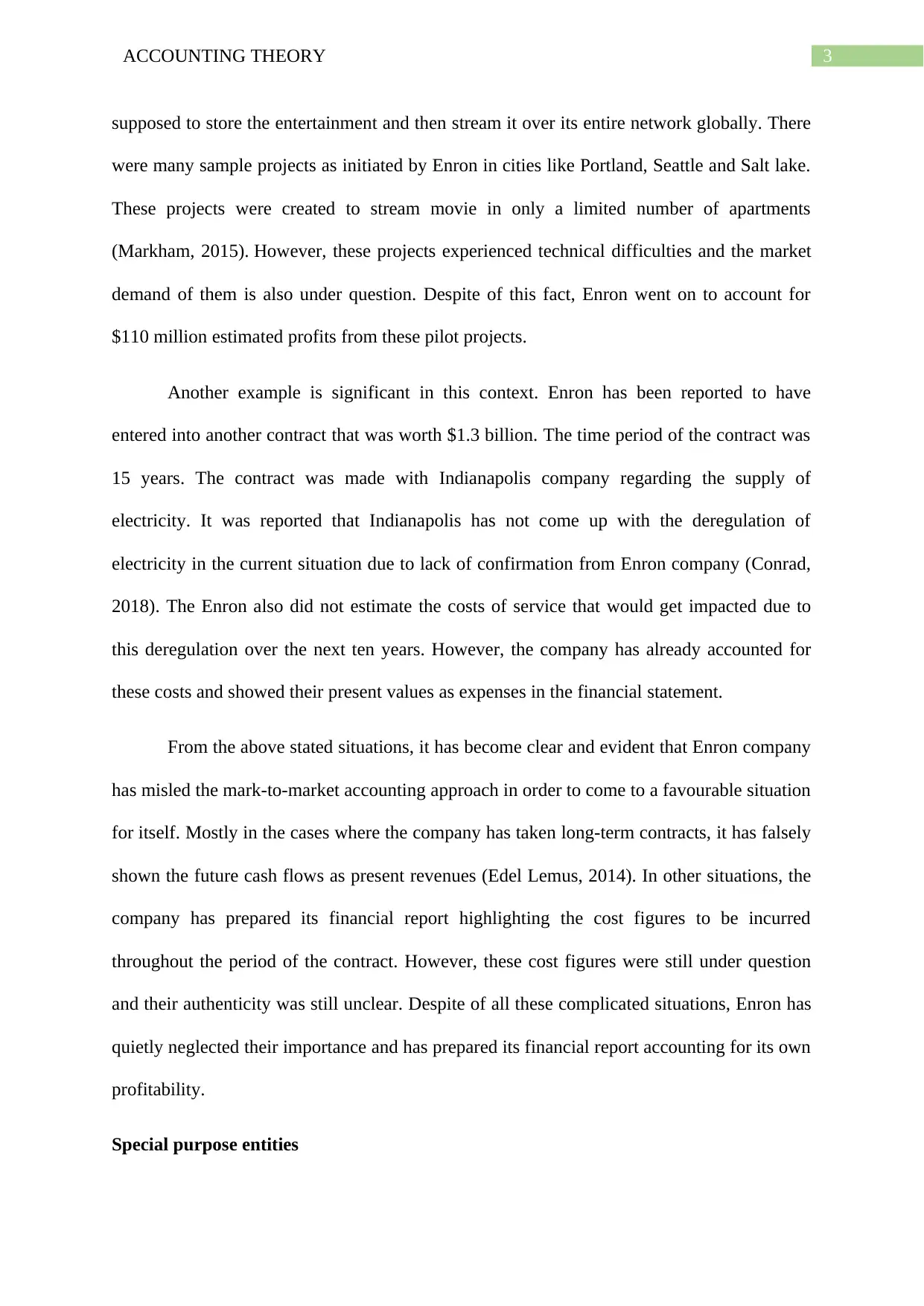
3ACCOUNTING THEORY
supposed to store the entertainment and then stream it over its entire network globally. There
were many sample projects as initiated by Enron in cities like Portland, Seattle and Salt lake.
These projects were created to stream movie in only a limited number of apartments
(Markham, 2015). However, these projects experienced technical difficulties and the market
demand of them is also under question. Despite of this fact, Enron went on to account for
$110 million estimated profits from these pilot projects.
Another example is significant in this context. Enron has been reported to have
entered into another contract that was worth $1.3 billion. The time period of the contract was
15 years. The contract was made with Indianapolis company regarding the supply of
electricity. It was reported that Indianapolis has not come up with the deregulation of
electricity in the current situation due to lack of confirmation from Enron company (Conrad,
2018). The Enron also did not estimate the costs of service that would get impacted due to
this deregulation over the next ten years. However, the company has already accounted for
these costs and showed their present values as expenses in the financial statement.
From the above stated situations, it has become clear and evident that Enron company
has misled the mark-to-market accounting approach in order to come to a favourable situation
for itself. Mostly in the cases where the company has taken long-term contracts, it has falsely
shown the future cash flows as present revenues (Edel Lemus, 2014). In other situations, the
company has prepared its financial report highlighting the cost figures to be incurred
throughout the period of the contract. However, these cost figures were still under question
and their authenticity was still unclear. Despite of all these complicated situations, Enron has
quietly neglected their importance and has prepared its financial report accounting for its own
profitability.
Special purpose entities
supposed to store the entertainment and then stream it over its entire network globally. There
were many sample projects as initiated by Enron in cities like Portland, Seattle and Salt lake.
These projects were created to stream movie in only a limited number of apartments
(Markham, 2015). However, these projects experienced technical difficulties and the market
demand of them is also under question. Despite of this fact, Enron went on to account for
$110 million estimated profits from these pilot projects.
Another example is significant in this context. Enron has been reported to have
entered into another contract that was worth $1.3 billion. The time period of the contract was
15 years. The contract was made with Indianapolis company regarding the supply of
electricity. It was reported that Indianapolis has not come up with the deregulation of
electricity in the current situation due to lack of confirmation from Enron company (Conrad,
2018). The Enron also did not estimate the costs of service that would get impacted due to
this deregulation over the next ten years. However, the company has already accounted for
these costs and showed their present values as expenses in the financial statement.
From the above stated situations, it has become clear and evident that Enron company
has misled the mark-to-market accounting approach in order to come to a favourable situation
for itself. Mostly in the cases where the company has taken long-term contracts, it has falsely
shown the future cash flows as present revenues (Edel Lemus, 2014). In other situations, the
company has prepared its financial report highlighting the cost figures to be incurred
throughout the period of the contract. However, these cost figures were still under question
and their authenticity was still unclear. Despite of all these complicated situations, Enron has
quietly neglected their importance and has prepared its financial report accounting for its own
profitability.
Special purpose entities
Paraphrase This Document
Need a fresh take? Get an instant paraphrase of this document with our AI Paraphraser
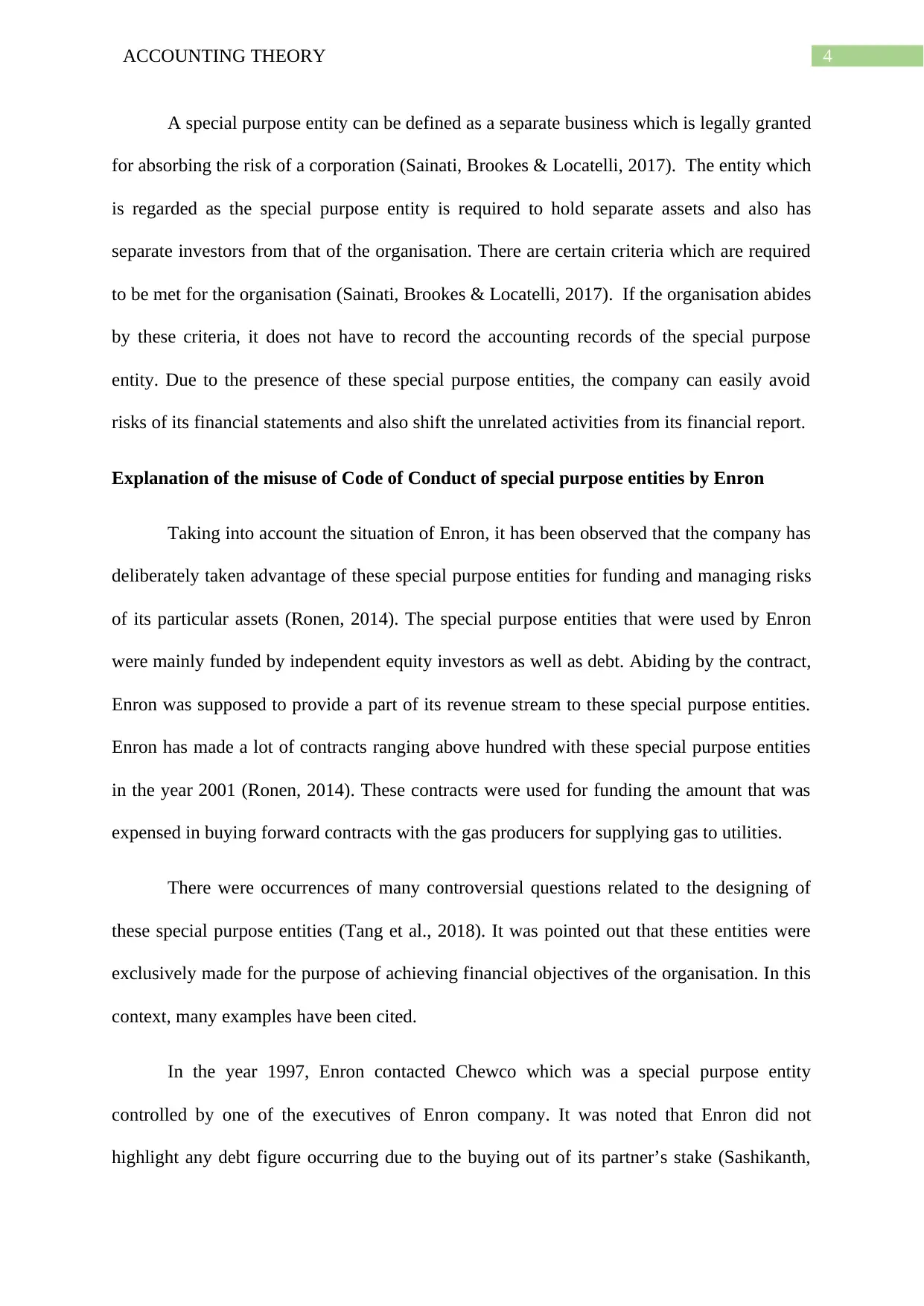
4ACCOUNTING THEORY
A special purpose entity can be defined as a separate business which is legally granted
for absorbing the risk of a corporation (Sainati, Brookes & Locatelli, 2017). The entity which
is regarded as the special purpose entity is required to hold separate assets and also has
separate investors from that of the organisation. There are certain criteria which are required
to be met for the organisation (Sainati, Brookes & Locatelli, 2017). If the organisation abides
by these criteria, it does not have to record the accounting records of the special purpose
entity. Due to the presence of these special purpose entities, the company can easily avoid
risks of its financial statements and also shift the unrelated activities from its financial report.
Explanation of the misuse of Code of Conduct of special purpose entities by Enron
Taking into account the situation of Enron, it has been observed that the company has
deliberately taken advantage of these special purpose entities for funding and managing risks
of its particular assets (Ronen, 2014). The special purpose entities that were used by Enron
were mainly funded by independent equity investors as well as debt. Abiding by the contract,
Enron was supposed to provide a part of its revenue stream to these special purpose entities.
Enron has made a lot of contracts ranging above hundred with these special purpose entities
in the year 2001 (Ronen, 2014). These contracts were used for funding the amount that was
expensed in buying forward contracts with the gas producers for supplying gas to utilities.
There were occurrences of many controversial questions related to the designing of
these special purpose entities (Tang et al., 2018). It was pointed out that these entities were
exclusively made for the purpose of achieving financial objectives of the organisation. In this
context, many examples have been cited.
In the year 1997, Enron contacted Chewco which was a special purpose entity
controlled by one of the executives of Enron company. It was noted that Enron did not
highlight any debt figure occurring due to the buying out of its partner’s stake (Sashikanth,
A special purpose entity can be defined as a separate business which is legally granted
for absorbing the risk of a corporation (Sainati, Brookes & Locatelli, 2017). The entity which
is regarded as the special purpose entity is required to hold separate assets and also has
separate investors from that of the organisation. There are certain criteria which are required
to be met for the organisation (Sainati, Brookes & Locatelli, 2017). If the organisation abides
by these criteria, it does not have to record the accounting records of the special purpose
entity. Due to the presence of these special purpose entities, the company can easily avoid
risks of its financial statements and also shift the unrelated activities from its financial report.
Explanation of the misuse of Code of Conduct of special purpose entities by Enron
Taking into account the situation of Enron, it has been observed that the company has
deliberately taken advantage of these special purpose entities for funding and managing risks
of its particular assets (Ronen, 2014). The special purpose entities that were used by Enron
were mainly funded by independent equity investors as well as debt. Abiding by the contract,
Enron was supposed to provide a part of its revenue stream to these special purpose entities.
Enron has made a lot of contracts ranging above hundred with these special purpose entities
in the year 2001 (Ronen, 2014). These contracts were used for funding the amount that was
expensed in buying forward contracts with the gas producers for supplying gas to utilities.
There were occurrences of many controversial questions related to the designing of
these special purpose entities (Tang et al., 2018). It was pointed out that these entities were
exclusively made for the purpose of achieving financial objectives of the organisation. In this
context, many examples have been cited.
In the year 1997, Enron contacted Chewco which was a special purpose entity
controlled by one of the executives of Enron company. It was noted that Enron did not
highlight any debt figure occurring due to the buying out of its partner’s stake (Sashikanth,
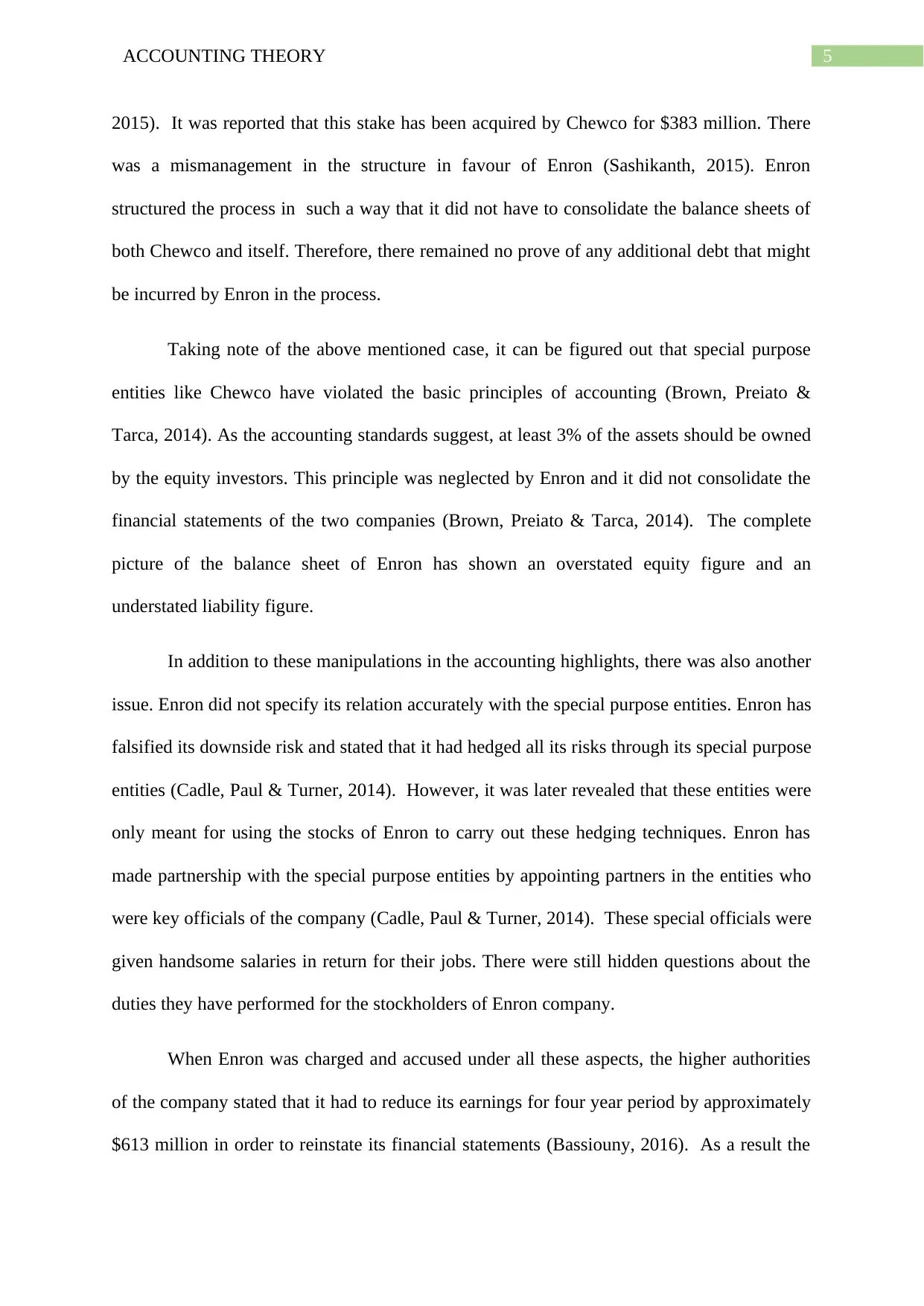
5ACCOUNTING THEORY
2015). It was reported that this stake has been acquired by Chewco for $383 million. There
was a mismanagement in the structure in favour of Enron (Sashikanth, 2015). Enron
structured the process in such a way that it did not have to consolidate the balance sheets of
both Chewco and itself. Therefore, there remained no prove of any additional debt that might
be incurred by Enron in the process.
Taking note of the above mentioned case, it can be figured out that special purpose
entities like Chewco have violated the basic principles of accounting (Brown, Preiato &
Tarca, 2014). As the accounting standards suggest, at least 3% of the assets should be owned
by the equity investors. This principle was neglected by Enron and it did not consolidate the
financial statements of the two companies (Brown, Preiato & Tarca, 2014). The complete
picture of the balance sheet of Enron has shown an overstated equity figure and an
understated liability figure.
In addition to these manipulations in the accounting highlights, there was also another
issue. Enron did not specify its relation accurately with the special purpose entities. Enron has
falsified its downside risk and stated that it had hedged all its risks through its special purpose
entities (Cadle, Paul & Turner, 2014). However, it was later revealed that these entities were
only meant for using the stocks of Enron to carry out these hedging techniques. Enron has
made partnership with the special purpose entities by appointing partners in the entities who
were key officials of the company (Cadle, Paul & Turner, 2014). These special officials were
given handsome salaries in return for their jobs. There were still hidden questions about the
duties they have performed for the stockholders of Enron company.
When Enron was charged and accused under all these aspects, the higher authorities
of the company stated that it had to reduce its earnings for four year period by approximately
$613 million in order to reinstate its financial statements (Bassiouny, 2016). As a result the
2015). It was reported that this stake has been acquired by Chewco for $383 million. There
was a mismanagement in the structure in favour of Enron (Sashikanth, 2015). Enron
structured the process in such a way that it did not have to consolidate the balance sheets of
both Chewco and itself. Therefore, there remained no prove of any additional debt that might
be incurred by Enron in the process.
Taking note of the above mentioned case, it can be figured out that special purpose
entities like Chewco have violated the basic principles of accounting (Brown, Preiato &
Tarca, 2014). As the accounting standards suggest, at least 3% of the assets should be owned
by the equity investors. This principle was neglected by Enron and it did not consolidate the
financial statements of the two companies (Brown, Preiato & Tarca, 2014). The complete
picture of the balance sheet of Enron has shown an overstated equity figure and an
understated liability figure.
In addition to these manipulations in the accounting highlights, there was also another
issue. Enron did not specify its relation accurately with the special purpose entities. Enron has
falsified its downside risk and stated that it had hedged all its risks through its special purpose
entities (Cadle, Paul & Turner, 2014). However, it was later revealed that these entities were
only meant for using the stocks of Enron to carry out these hedging techniques. Enron has
made partnership with the special purpose entities by appointing partners in the entities who
were key officials of the company (Cadle, Paul & Turner, 2014). These special officials were
given handsome salaries in return for their jobs. There were still hidden questions about the
duties they have performed for the stockholders of Enron company.
When Enron was charged and accused under all these aspects, the higher authorities
of the company stated that it had to reduce its earnings for four year period by approximately
$613 million in order to reinstate its financial statements (Bassiouny, 2016). As a result the
⊘ This is a preview!⊘
Do you want full access?
Subscribe today to unlock all pages.

Trusted by 1+ million students worldwide
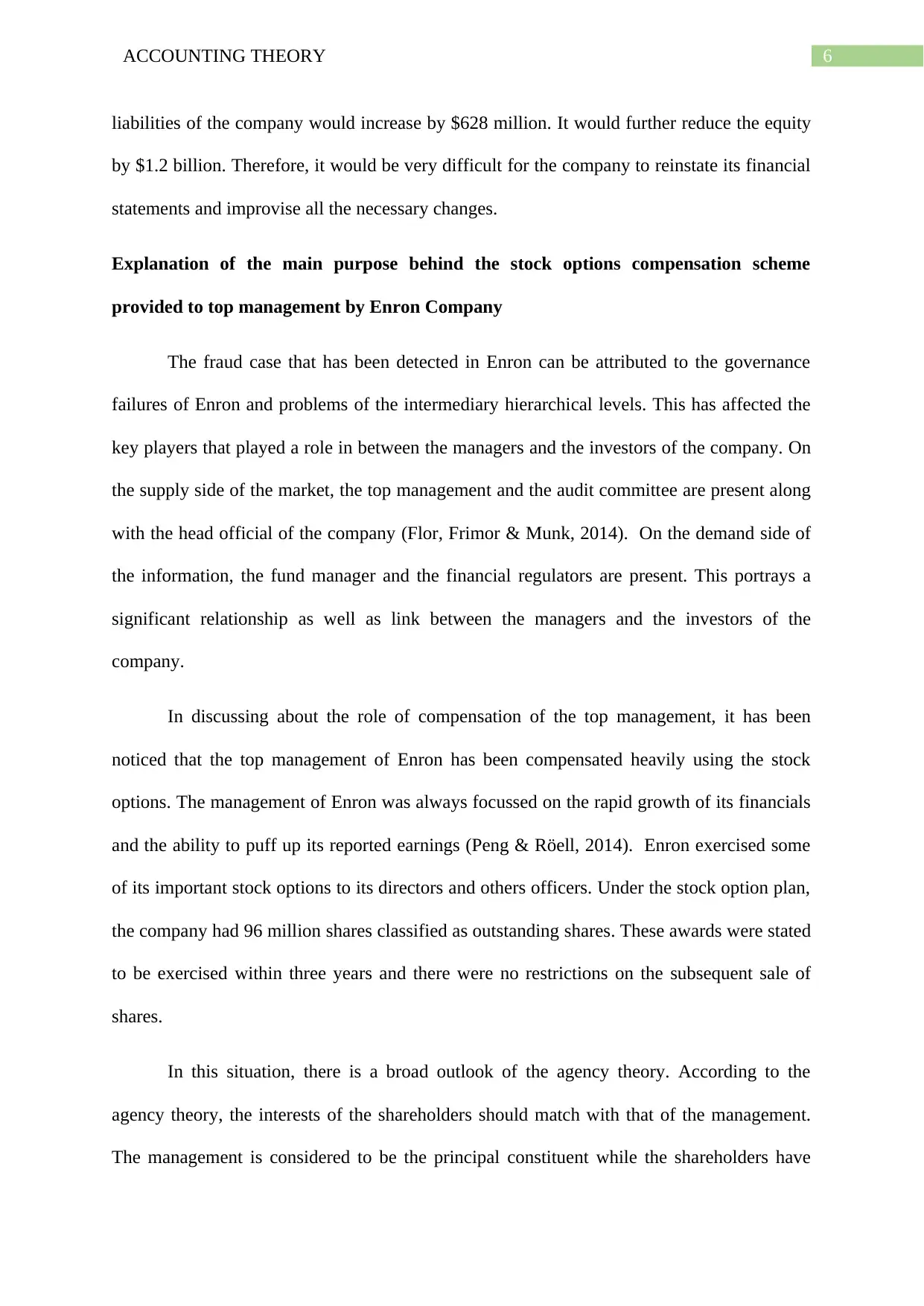
6ACCOUNTING THEORY
liabilities of the company would increase by $628 million. It would further reduce the equity
by $1.2 billion. Therefore, it would be very difficult for the company to reinstate its financial
statements and improvise all the necessary changes.
Explanation of the main purpose behind the stock options compensation scheme
provided to top management by Enron Company
The fraud case that has been detected in Enron can be attributed to the governance
failures of Enron and problems of the intermediary hierarchical levels. This has affected the
key players that played a role in between the managers and the investors of the company. On
the supply side of the market, the top management and the audit committee are present along
with the head official of the company (Flor, Frimor & Munk, 2014). On the demand side of
the information, the fund manager and the financial regulators are present. This portrays a
significant relationship as well as link between the managers and the investors of the
company.
In discussing about the role of compensation of the top management, it has been
noticed that the top management of Enron has been compensated heavily using the stock
options. The management of Enron was always focussed on the rapid growth of its financials
and the ability to puff up its reported earnings (Peng & Röell, 2014). Enron exercised some
of its important stock options to its directors and others officers. Under the stock option plan,
the company had 96 million shares classified as outstanding shares. These awards were stated
to be exercised within three years and there were no restrictions on the subsequent sale of
shares.
In this situation, there is a broad outlook of the agency theory. According to the
agency theory, the interests of the shareholders should match with that of the management.
The management is considered to be the principal constituent while the shareholders have
liabilities of the company would increase by $628 million. It would further reduce the equity
by $1.2 billion. Therefore, it would be very difficult for the company to reinstate its financial
statements and improvise all the necessary changes.
Explanation of the main purpose behind the stock options compensation scheme
provided to top management by Enron Company
The fraud case that has been detected in Enron can be attributed to the governance
failures of Enron and problems of the intermediary hierarchical levels. This has affected the
key players that played a role in between the managers and the investors of the company. On
the supply side of the market, the top management and the audit committee are present along
with the head official of the company (Flor, Frimor & Munk, 2014). On the demand side of
the information, the fund manager and the financial regulators are present. This portrays a
significant relationship as well as link between the managers and the investors of the
company.
In discussing about the role of compensation of the top management, it has been
noticed that the top management of Enron has been compensated heavily using the stock
options. The management of Enron was always focussed on the rapid growth of its financials
and the ability to puff up its reported earnings (Peng & Röell, 2014). Enron exercised some
of its important stock options to its directors and others officers. Under the stock option plan,
the company had 96 million shares classified as outstanding shares. These awards were stated
to be exercised within three years and there were no restrictions on the subsequent sale of
shares.
In this situation, there is a broad outlook of the agency theory. According to the
agency theory, the interests of the shareholders should match with that of the management.
The management is considered to be the principal constituent while the shareholders have
Paraphrase This Document
Need a fresh take? Get an instant paraphrase of this document with our AI Paraphraser
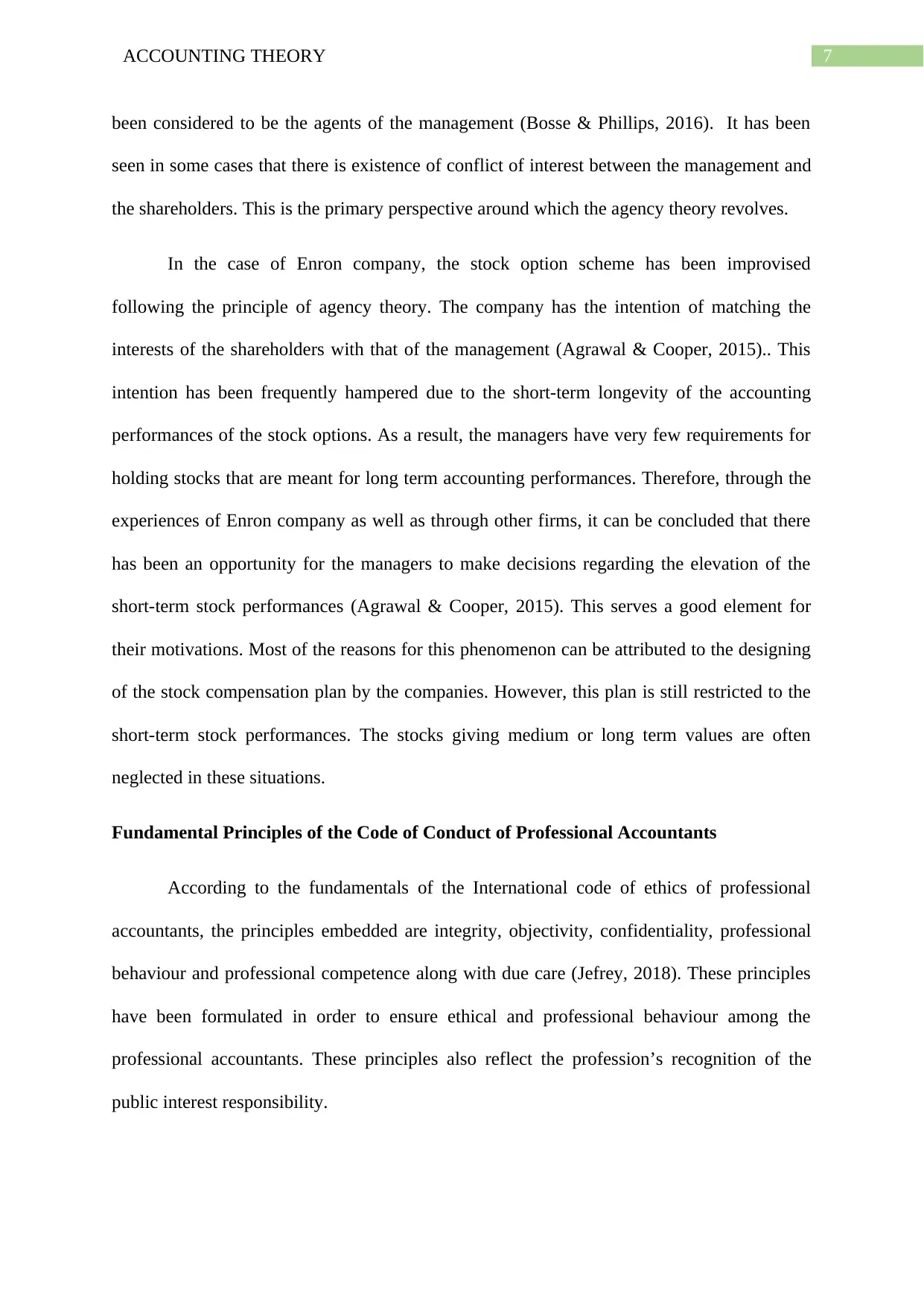
7ACCOUNTING THEORY
been considered to be the agents of the management (Bosse & Phillips, 2016). It has been
seen in some cases that there is existence of conflict of interest between the management and
the shareholders. This is the primary perspective around which the agency theory revolves.
In the case of Enron company, the stock option scheme has been improvised
following the principle of agency theory. The company has the intention of matching the
interests of the shareholders with that of the management (Agrawal & Cooper, 2015).. This
intention has been frequently hampered due to the short-term longevity of the accounting
performances of the stock options. As a result, the managers have very few requirements for
holding stocks that are meant for long term accounting performances. Therefore, through the
experiences of Enron company as well as through other firms, it can be concluded that there
has been an opportunity for the managers to make decisions regarding the elevation of the
short-term stock performances (Agrawal & Cooper, 2015). This serves a good element for
their motivations. Most of the reasons for this phenomenon can be attributed to the designing
of the stock compensation plan by the companies. However, this plan is still restricted to the
short-term stock performances. The stocks giving medium or long term values are often
neglected in these situations.
Fundamental Principles of the Code of Conduct of Professional Accountants
According to the fundamentals of the International code of ethics of professional
accountants, the principles embedded are integrity, objectivity, confidentiality, professional
behaviour and professional competence along with due care (Jefrey, 2018). These principles
have been formulated in order to ensure ethical and professional behaviour among the
professional accountants. These principles also reflect the profession’s recognition of the
public interest responsibility.
been considered to be the agents of the management (Bosse & Phillips, 2016). It has been
seen in some cases that there is existence of conflict of interest between the management and
the shareholders. This is the primary perspective around which the agency theory revolves.
In the case of Enron company, the stock option scheme has been improvised
following the principle of agency theory. The company has the intention of matching the
interests of the shareholders with that of the management (Agrawal & Cooper, 2015).. This
intention has been frequently hampered due to the short-term longevity of the accounting
performances of the stock options. As a result, the managers have very few requirements for
holding stocks that are meant for long term accounting performances. Therefore, through the
experiences of Enron company as well as through other firms, it can be concluded that there
has been an opportunity for the managers to make decisions regarding the elevation of the
short-term stock performances (Agrawal & Cooper, 2015). This serves a good element for
their motivations. Most of the reasons for this phenomenon can be attributed to the designing
of the stock compensation plan by the companies. However, this plan is still restricted to the
short-term stock performances. The stocks giving medium or long term values are often
neglected in these situations.
Fundamental Principles of the Code of Conduct of Professional Accountants
According to the fundamentals of the International code of ethics of professional
accountants, the principles embedded are integrity, objectivity, confidentiality, professional
behaviour and professional competence along with due care (Jefrey, 2018). These principles
have been formulated in order to ensure ethical and professional behaviour among the
professional accountants. These principles also reflect the profession’s recognition of the
public interest responsibility.
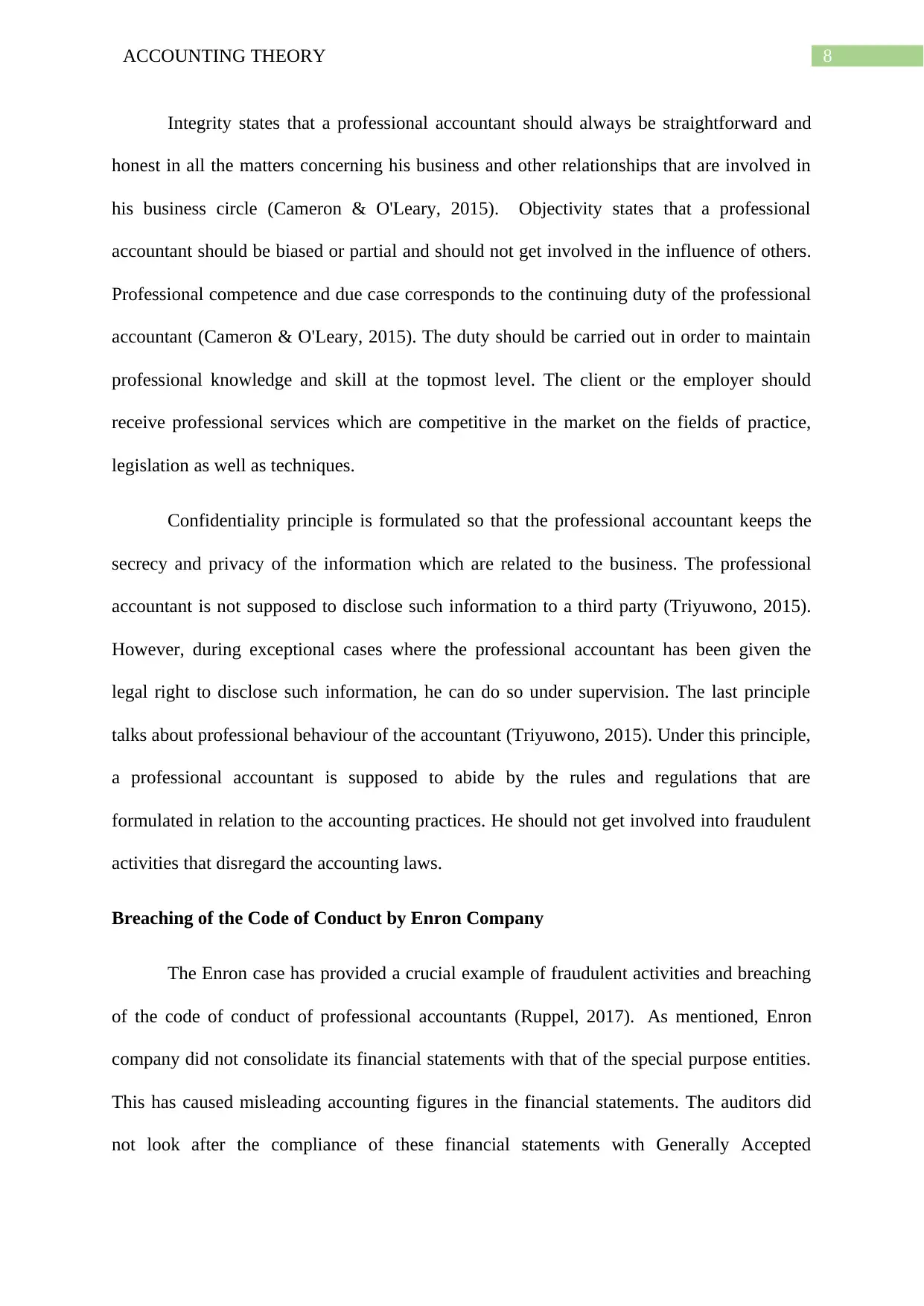
8ACCOUNTING THEORY
Integrity states that a professional accountant should always be straightforward and
honest in all the matters concerning his business and other relationships that are involved in
his business circle (Cameron & O'Leary, 2015). Objectivity states that a professional
accountant should be biased or partial and should not get involved in the influence of others.
Professional competence and due case corresponds to the continuing duty of the professional
accountant (Cameron & O'Leary, 2015). The duty should be carried out in order to maintain
professional knowledge and skill at the topmost level. The client or the employer should
receive professional services which are competitive in the market on the fields of practice,
legislation as well as techniques.
Confidentiality principle is formulated so that the professional accountant keeps the
secrecy and privacy of the information which are related to the business. The professional
accountant is not supposed to disclose such information to a third party (Triyuwono, 2015).
However, during exceptional cases where the professional accountant has been given the
legal right to disclose such information, he can do so under supervision. The last principle
talks about professional behaviour of the accountant (Triyuwono, 2015). Under this principle,
a professional accountant is supposed to abide by the rules and regulations that are
formulated in relation to the accounting practices. He should not get involved into fraudulent
activities that disregard the accounting laws.
Breaching of the Code of Conduct by Enron Company
The Enron case has provided a crucial example of fraudulent activities and breaching
of the code of conduct of professional accountants (Ruppel, 2017). As mentioned, Enron
company did not consolidate its financial statements with that of the special purpose entities.
This has caused misleading accounting figures in the financial statements. The auditors did
not look after the compliance of these financial statements with Generally Accepted
Integrity states that a professional accountant should always be straightforward and
honest in all the matters concerning his business and other relationships that are involved in
his business circle (Cameron & O'Leary, 2015). Objectivity states that a professional
accountant should be biased or partial and should not get involved in the influence of others.
Professional competence and due case corresponds to the continuing duty of the professional
accountant (Cameron & O'Leary, 2015). The duty should be carried out in order to maintain
professional knowledge and skill at the topmost level. The client or the employer should
receive professional services which are competitive in the market on the fields of practice,
legislation as well as techniques.
Confidentiality principle is formulated so that the professional accountant keeps the
secrecy and privacy of the information which are related to the business. The professional
accountant is not supposed to disclose such information to a third party (Triyuwono, 2015).
However, during exceptional cases where the professional accountant has been given the
legal right to disclose such information, he can do so under supervision. The last principle
talks about professional behaviour of the accountant (Triyuwono, 2015). Under this principle,
a professional accountant is supposed to abide by the rules and regulations that are
formulated in relation to the accounting practices. He should not get involved into fraudulent
activities that disregard the accounting laws.
Breaching of the Code of Conduct by Enron Company
The Enron case has provided a crucial example of fraudulent activities and breaching
of the code of conduct of professional accountants (Ruppel, 2017). As mentioned, Enron
company did not consolidate its financial statements with that of the special purpose entities.
This has caused misleading accounting figures in the financial statements. The auditors did
not look after the compliance of these financial statements with Generally Accepted
⊘ This is a preview!⊘
Do you want full access?
Subscribe today to unlock all pages.

Trusted by 1+ million students worldwide
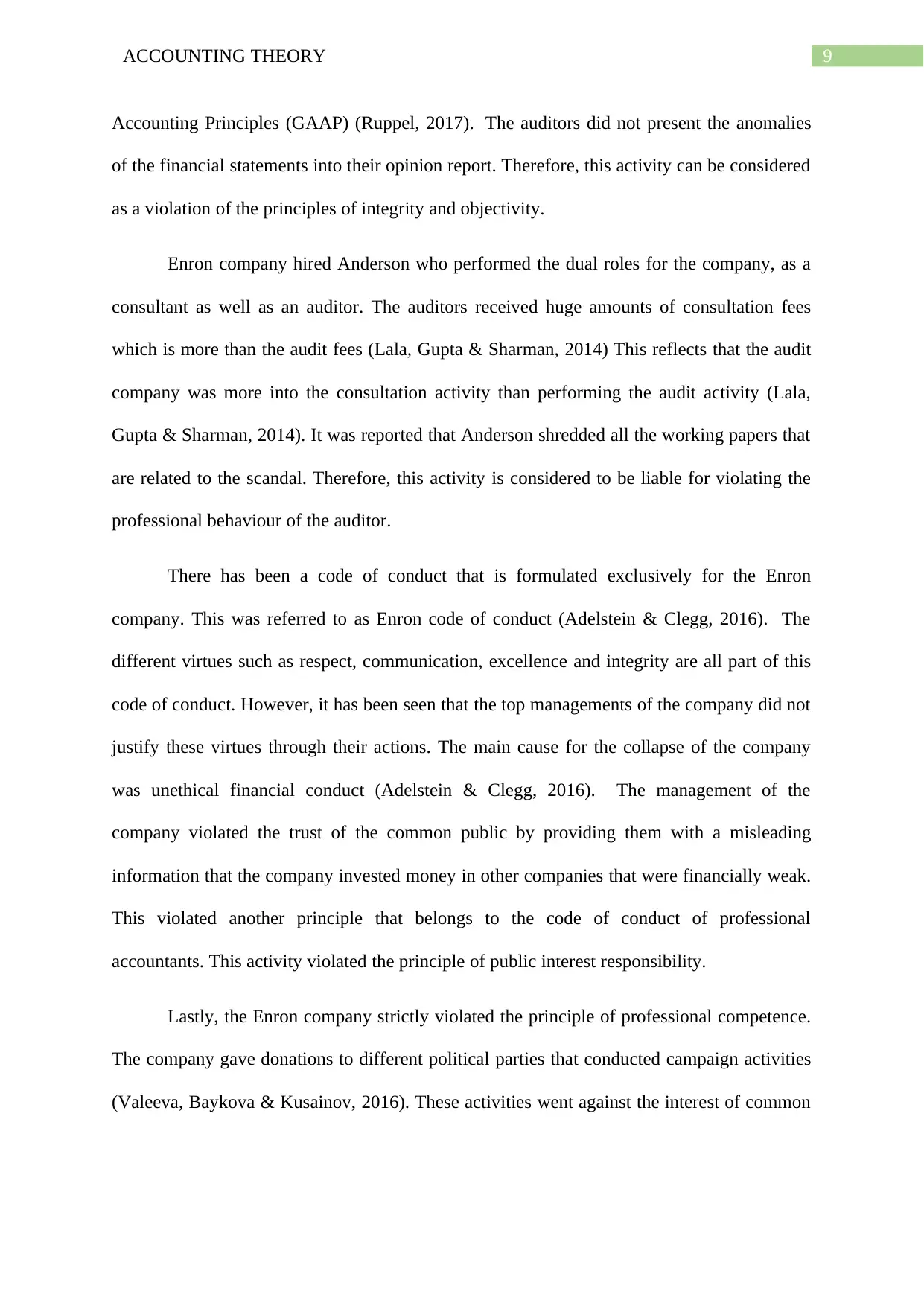
9ACCOUNTING THEORY
Accounting Principles (GAAP) (Ruppel, 2017). The auditors did not present the anomalies
of the financial statements into their opinion report. Therefore, this activity can be considered
as a violation of the principles of integrity and objectivity.
Enron company hired Anderson who performed the dual roles for the company, as a
consultant as well as an auditor. The auditors received huge amounts of consultation fees
which is more than the audit fees (Lala, Gupta & Sharman, 2014) This reflects that the audit
company was more into the consultation activity than performing the audit activity (Lala,
Gupta & Sharman, 2014). It was reported that Anderson shredded all the working papers that
are related to the scandal. Therefore, this activity is considered to be liable for violating the
professional behaviour of the auditor.
There has been a code of conduct that is formulated exclusively for the Enron
company. This was referred to as Enron code of conduct (Adelstein & Clegg, 2016). The
different virtues such as respect, communication, excellence and integrity are all part of this
code of conduct. However, it has been seen that the top managements of the company did not
justify these virtues through their actions. The main cause for the collapse of the company
was unethical financial conduct (Adelstein & Clegg, 2016). The management of the
company violated the trust of the common public by providing them with a misleading
information that the company invested money in other companies that were financially weak.
This violated another principle that belongs to the code of conduct of professional
accountants. This activity violated the principle of public interest responsibility.
Lastly, the Enron company strictly violated the principle of professional competence.
The company gave donations to different political parties that conducted campaign activities
(Valeeva, Baykova & Kusainov, 2016). These activities went against the interest of common
Accounting Principles (GAAP) (Ruppel, 2017). The auditors did not present the anomalies
of the financial statements into their opinion report. Therefore, this activity can be considered
as a violation of the principles of integrity and objectivity.
Enron company hired Anderson who performed the dual roles for the company, as a
consultant as well as an auditor. The auditors received huge amounts of consultation fees
which is more than the audit fees (Lala, Gupta & Sharman, 2014) This reflects that the audit
company was more into the consultation activity than performing the audit activity (Lala,
Gupta & Sharman, 2014). It was reported that Anderson shredded all the working papers that
are related to the scandal. Therefore, this activity is considered to be liable for violating the
professional behaviour of the auditor.
There has been a code of conduct that is formulated exclusively for the Enron
company. This was referred to as Enron code of conduct (Adelstein & Clegg, 2016). The
different virtues such as respect, communication, excellence and integrity are all part of this
code of conduct. However, it has been seen that the top managements of the company did not
justify these virtues through their actions. The main cause for the collapse of the company
was unethical financial conduct (Adelstein & Clegg, 2016). The management of the
company violated the trust of the common public by providing them with a misleading
information that the company invested money in other companies that were financially weak.
This violated another principle that belongs to the code of conduct of professional
accountants. This activity violated the principle of public interest responsibility.
Lastly, the Enron company strictly violated the principle of professional competence.
The company gave donations to different political parties that conducted campaign activities
(Valeeva, Baykova & Kusainov, 2016). These activities went against the interest of common
Paraphrase This Document
Need a fresh take? Get an instant paraphrase of this document with our AI Paraphraser

10ACCOUNTING THEORY
public and provided the company with an unfair competitive advantage over all its
competitors.
Conclusion
From the above essay, it can be concluded that the scandal that led to the collapse of
the Enron company, has been a very significant case in the history of financial accounting.
Under this phenomenon, the important observed anomalies are stated and explained. The first
anomaly has been observed in the mark-to-market approach which has been deliberately
misused by the company for reflecting a good picture of its performance as well as its
profitability. Next, the essay emphasised on the implications of the special purpose entities
and the extent till which the company exploited them for funding contracts and achieving its
long term financial goals. The company proposed a stock option scheme that had the
intention of aligning the interest of the management with that of the shareholders. In this
respect, the concepts gained from agency theory has been elaborated. At the last section, the
essay ends with a brief description of the principles that were stated in the code of conduct of
professional accountants. Enron company has been observed to have violated most of these
principles. The key principles that have been breached by the company are stated along with
suitable examples of each.
public and provided the company with an unfair competitive advantage over all its
competitors.
Conclusion
From the above essay, it can be concluded that the scandal that led to the collapse of
the Enron company, has been a very significant case in the history of financial accounting.
Under this phenomenon, the important observed anomalies are stated and explained. The first
anomaly has been observed in the mark-to-market approach which has been deliberately
misused by the company for reflecting a good picture of its performance as well as its
profitability. Next, the essay emphasised on the implications of the special purpose entities
and the extent till which the company exploited them for funding contracts and achieving its
long term financial goals. The company proposed a stock option scheme that had the
intention of aligning the interest of the management with that of the shareholders. In this
respect, the concepts gained from agency theory has been elaborated. At the last section, the
essay ends with a brief description of the principles that were stated in the code of conduct of
professional accountants. Enron company has been observed to have violated most of these
principles. The key principles that have been breached by the company are stated along with
suitable examples of each.

11ACCOUNTING THEORY
References
Adelstein, J., & Clegg, S. (2016). Code of ethics: A stratified vehicle for compliance. Journal
of Business Ethics, 138(1), 53-66.
Agrawal, A., & Cooper, T. (2015). Insider trading before accounting scandals. Journal of
Corporate Finance, 34, 169-190.
Bassiouny, S. W. (2016). The impact of firm characteristics on earnings management: an
empirical study on the listed firms in Egypt. Journal of Business and Retail
Management Research, 10(3).
Bosse, D. A., & Phillips, R. A. (2016). Agency theory and bounded self-interest. Academy of
Management Review, 41(2), 276-297.
Brown, P., Preiato, J., & Tarca, A. (2014). Measuring country differences in enforcement of
accounting standards: An audit and enforcement proxy. Journal of Business Finance
& Accounting, 41(1-2), 1-52.
Cadle, J., Paul, D., & Turner, P. (2014). Business analysis techniques. Chartered Institute for
IT.
Cameron, R. A., & O'Leary, C. (2015). Improving ethical attitudes or simply teaching ethical
codes? The reality of accounting ethics education. Accounting Education, 24(4), 275-
290.
Conrad, C. A. (2018). Ethical Problems of the Economy: Enron, Subprime & Co.–From
Crisis to Crisis. In Business Ethics-A Philosophical and Behavioral Approach (pp. 69-
97). Springer, Cham.
References
Adelstein, J., & Clegg, S. (2016). Code of ethics: A stratified vehicle for compliance. Journal
of Business Ethics, 138(1), 53-66.
Agrawal, A., & Cooper, T. (2015). Insider trading before accounting scandals. Journal of
Corporate Finance, 34, 169-190.
Bassiouny, S. W. (2016). The impact of firm characteristics on earnings management: an
empirical study on the listed firms in Egypt. Journal of Business and Retail
Management Research, 10(3).
Bosse, D. A., & Phillips, R. A. (2016). Agency theory and bounded self-interest. Academy of
Management Review, 41(2), 276-297.
Brown, P., Preiato, J., & Tarca, A. (2014). Measuring country differences in enforcement of
accounting standards: An audit and enforcement proxy. Journal of Business Finance
& Accounting, 41(1-2), 1-52.
Cadle, J., Paul, D., & Turner, P. (2014). Business analysis techniques. Chartered Institute for
IT.
Cameron, R. A., & O'Leary, C. (2015). Improving ethical attitudes or simply teaching ethical
codes? The reality of accounting ethics education. Accounting Education, 24(4), 275-
290.
Conrad, C. A. (2018). Ethical Problems of the Economy: Enron, Subprime & Co.–From
Crisis to Crisis. In Business Ethics-A Philosophical and Behavioral Approach (pp. 69-
97). Springer, Cham.
⊘ This is a preview!⊘
Do you want full access?
Subscribe today to unlock all pages.

Trusted by 1+ million students worldwide
1 out of 14
Related Documents
Your All-in-One AI-Powered Toolkit for Academic Success.
+13062052269
info@desklib.com
Available 24*7 on WhatsApp / Email
![[object Object]](/_next/static/media/star-bottom.7253800d.svg)
Unlock your academic potential
Copyright © 2020–2025 A2Z Services. All Rights Reserved. Developed and managed by ZUCOL.




